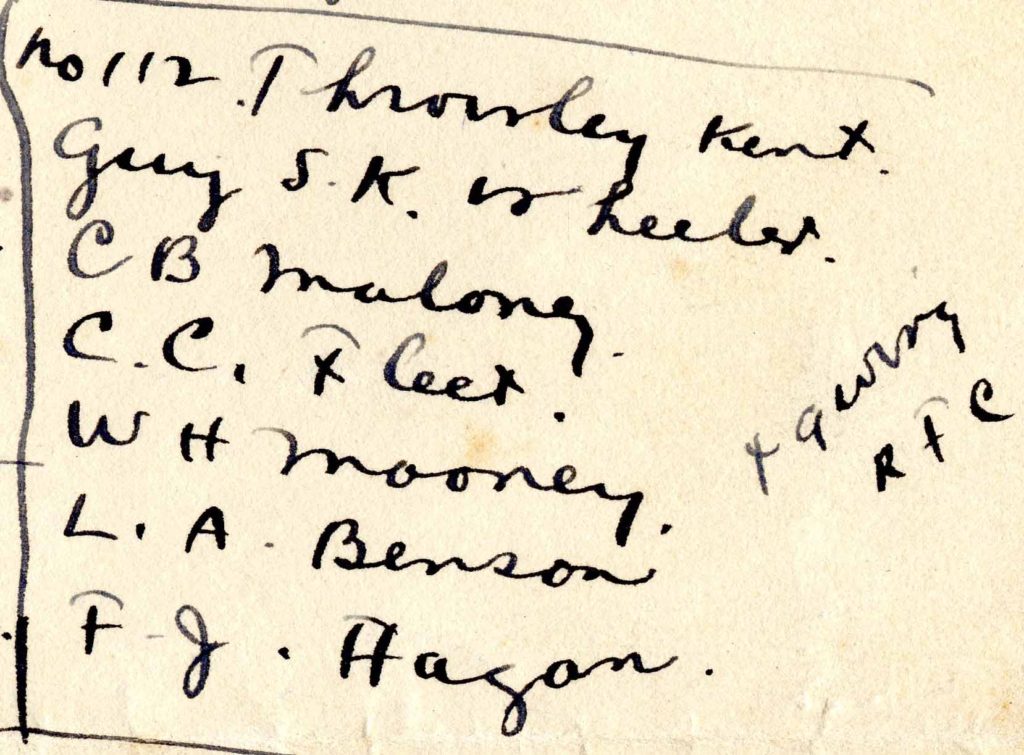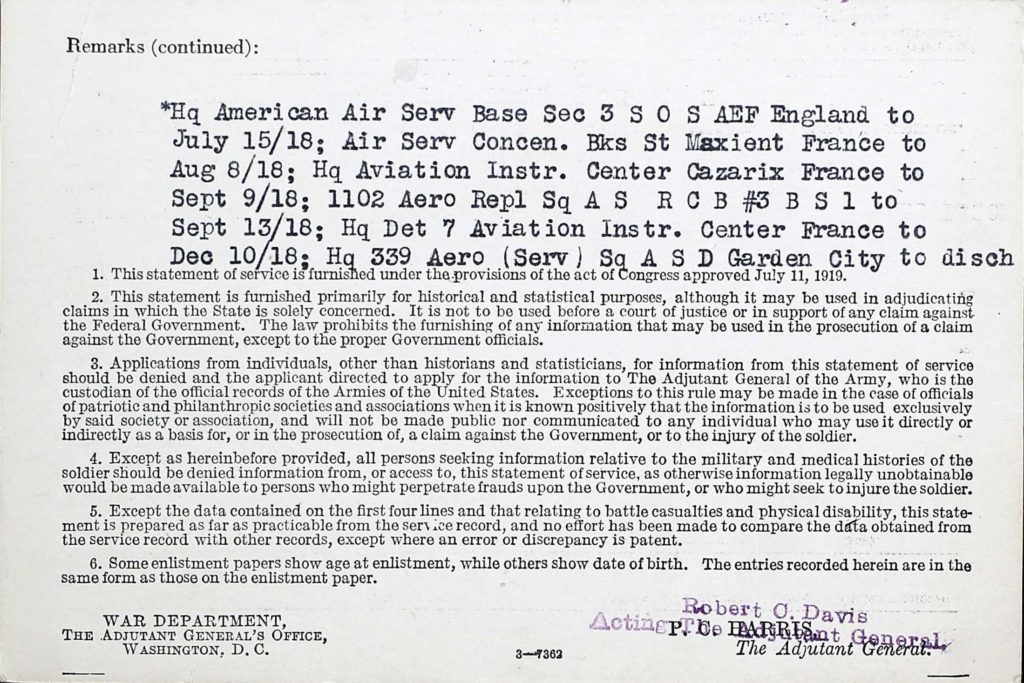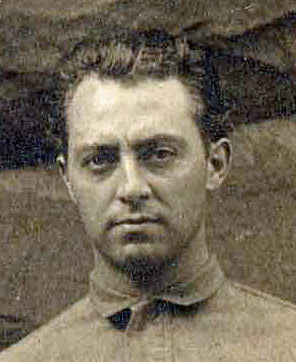(Philadelphia, June 22, 1890 – Darby, Pennsylvania, January 30, 1963).1
Hagan was of Irish descent; his father worked as a real estate broker in Philadelphia.2 I have not found records of school or college attendance, but by the time he registered for the draft on June 5, 1917, Hagan was working as an attorney in Washington, D.C. He attended ground school at Ohio State University, graduating September 1, 1917.3
Along with most of the rest of his O.S.U. classmates, Hagan chose or was chosen for training in Italy and sailed with the 150 men of the “Italian” or “second Oxford detachment” on the Carmania, departing New York for Halifax on September 18, 1917, and departing Halifax as part of a convoy for the Atlantic crossing on September 21, 1917. Hagan’s ground school classmate Fremont Cutler Foss describes how a group of the men celebrated their imminent arrival in England and the cessation of submarine watch duty: “Last night about 11:30 the gang: Dietz, Forster, Deetjen, Neil [sic], Hagan, Fry and many others had a feast with food prepared for the guard which was called off at 9:30. Twenty loaves of bread and about twenty pounds of meat were ruined.”4 When the Carmania docked at Liverpool on October 2, 1918, the men learned that they were not to go to Italy after all, but to remain in England and go through ground school again, this time at the Royal Flying Corps’s No. 2 School of Military Aeronautics at Oxford University.
A month later, on November 3, 1917, Hagan, along with most of the rest of the detachment left for machine gun school at Harrowby Camp, near Grantham, in Lincolnshire. Hagan was not among the fifty who left Grantham for flying schools on November 19, 1918, but instead remained at Grantham through early December. Foss mentions in passing a dance that “Hagan and Bird arranged” a week before Thanksgiving.5

Finally, on December 3, 1917, the remaining men were posted to flying squadrons, and Hagan, along with Leslie A. A. Benson, Charles Carvel Fleet, Clarence Bernard Maloney, William Henley Mooney, and Guy Samuel King Wheeler, went to No. 112 Squadron, a home defense squadron at Throwley in Kent.6 No. 112 flew Camels, which, of course, could not be used for primary instruction. There must also, however, have been some two seaters; Fleet wrote to Parr Hooper from Throwley that the cadets “are billeted in nice homes and do not do anything except occasional flying when the pilots feel like taking them up.”7
According to his R.A.F. service record, Hagan went from Throwley to Boscombe Down in Wiltshire on January 26, 1918, presumably to No. 6 Training Depot Squadron where his fellow second Oxford detachment member Robert Jenkins Griffith was assigned that day.8 According to a letter Hagan wrote to Benson on or about the 9th of February, instruction initially proceeded slowly: “So far I have done 1 hr and 5 min dual in the 2 weeks that I have been here.”8a

At 6 T.D.S. Hagan could have begun training on DH.6s (a two-seater plane designed for training purposes) or on Avros or B.E.2c’s or B.E.2e’s (once operational two-seater aircraft now obsolete and used for instruction). He could have moved on to D.H.4s and D.H.9s, as well as B.E.12s, FK.8s and perhaps R.E.8s; the goal was to produce observation and bomber rather than scout pilots.9 However, two months after his transfer to Boscombe Down, on March 21, 1918, a medical examination, whose results are recorded on his R.A.F. service record, determined that Hagan was “unfit for G[eneral] S[ervice] for two months” and “P[ermanently] U[nfit] for further instr.[uction] in flying.” A medical card notes that he is “Fit H[ome] S[ervice],” but “Permanently unfit as pilot or observer.” His disability is recorded as “nervous strain.”10 I find no record of Hagan’s having been commissioned, so he had apparently not reached the point in his training that would have prompted a recommendation for a lieutenancy. The next and chronologically last notation on Hagan’s R.A.F. service record has him relocated from Boscombe Down to nearby Romsey Rest Camp on May 9, 1918.

Hagan’s Pennsylvania service card lists his subsequent postings; I assume he served in an administrative capacity.11 Until mid July 1918, he was at Base Section 3 of the American Air Service Service of Supply for the A.E.F. in England; this section was tasked with “the care of American troops passing through England to France.”12 From then until August 8, 1918, Hagan was at the Air Service Concentration Barracks at Saint-Maixent-l’École, France.12a St. Maixent, about fifty miles from the Atlantic coast, east of St. Rochelle, served as a receiving and distribution depot for American personnel arriving in France. From there he served until September 9, 1918, at the Cazaux Aviation Instruction Center, about thirty-five miles southwest of Bordeaux. He then went to the 7th Aviation Instruction Center at Clermont-Ferrand, where he remained until December 10, 1918. Hagan returned home on the S. S. Niew Amsterdam, which departed Brest on December 27, 1918, and arrived at New York on January 5, 1919.13 He was honorably discharged on January 18, 1919.14
After the war, Hagan returned to practicing law, initially in Philadelphia, then in New York, where he and his wife and her children were socially prominent.15
mrsmcq 2018; revised October 28, 2022, to reflect letter to Benson
Notes
(For complete bibliographic entries, please consult the list of works and web pages cited.)
1 Hagan’s place and date of birth are taken from Ancestry.com, U.S., World War I Draft Registration Cards, 1917–1918, record for Francis Joseph Hagan. He has on occasion been confused with another man of the same name, born in 1892, who briefly attended the Naval Academy. His place and date of death are taken from Ancestry.com, Pennsylvania, Death Certificates, 1906–1963, record for Francis J Hagan. The photo is a detail from a group photo of Squadron 8 at the Ohio State University School of Military Aeronautics.
2 See Ancestry.com, 1920 United States Federal Census, record for James J Hagan.
3 See “Ground School Graduations [for September 1, 1917].”
4 Foss, Diary, October 2, 1917.
5 Foss, Diary, November 22, 1917.
6 See Foss, diary entry for November 30, 1918; and Foss, “Cadets of Italian Detachment Posted Dec 3rd” (in Foss, Papers). See also Hooper, Somewhere in France, letter of December 18, 1917.
7 Hooper, Somewhere in France, letter of December 18, 1917.
8 See The National Archives (United Kingdom), Royal Air Force officers’ service records 1918–1919, record for F. J. Hagan.
8a The letter and envelope are in Benson, Miscellaneous papers and photos.
9 On the planes available at No. 6 T.D.S., see Sturtivant, Hamlin, and Halley, Royal Air Force Flying Training and Support Units, p. 294, as well as “Introduction and new Question TDStations” (post #5 by mickdavis); Sturtivant et al. do not list the R.E.8, while mickdavis does.
10 I am grateful to the staff of the RAF Museum London for a scan of Hagan’s medical card.
11 See Ancestry.com, Pennsylvania, WWI Veterans Service and Compensation Files, 1917–1919, 1934–1948, record for Francis J Hagan.
12 United States, War Department, General Staff, Organization of the Services of Supply, American Expeditionary Forces, p. 22.
12a Dwyer, “Memorandum No. 8 for Flying Officers” (dated July 30, 1918), p. 4, includes “Cadet F. J. Hagan” in a list of six men at St. Maixent.
13 See War Department, Office of the Quartermaster General, Army Transport Service. Lists of Incoming Passengers, 1917 – 1938, Passenger list for S. S. Niew Amsterdam, p. 2.
14 Ancestry.com, Pennsylvania, WWI Veterans Service and Compensation Files, 1917–1919, 1934–1948, record for Francis J Hagan.
15 See, for example, “Cantarrana–Ledere.”

